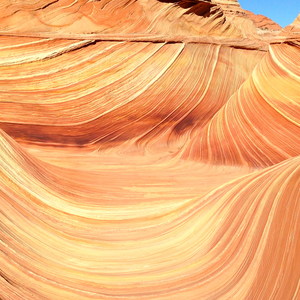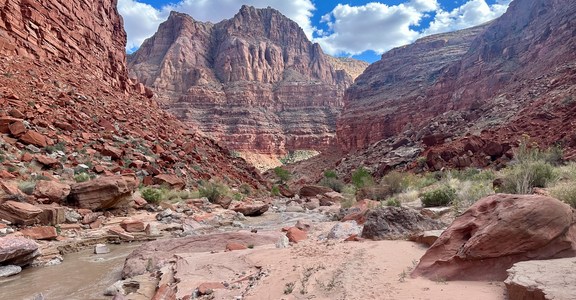You are here
Overview | Permits | Logistics | Approximate Mileages and Times| Safety and Preparation | Overnight Trips
The famous Buckskin Gulch canyon hike has topped multiple "World's Most" lists in magazines and online. It is thought to be the longest slot canyon in the world, meaning no other canyon runs as narrow for as many miles. It has also been called the world's most dangerous hike. This is because of flash flood danger, which is a very real threat during parts of the year. Despite the risk, this is known as one of the best canyon hikes anywhere. Regardless of what list you place it on, Buckskin Gulch is a geologic wonder that is actually very accessible, doable, and immensely rewarding if you prepare properly.
This slot canyon runs practically uninterrupted for 15 miles, and it intersects with the narrows of Paria River Canyon, adding to the scale. There are pools to wade, muddy stretches to slog through, rocks to scramble, and rivers to cross, but the majority is flat and dry. To hike the full length of Buckskin and out along the Paria is 23.6 miles (car shuttle required), but the canyon is passable in either direction, so out-and-back day trips of any distance are possible.
Buckskin Gulch has an intimidating reputation, but it can be enjoyed by anyone with proper preparation. Many miles into 200-foot-deep narrows is not the place to test your limits, so know what you and your group members can handle before you get there. The hike is long and grueling, but it requires no technical canyoneering knowledge. What it takes is simple awareness of canyon safety, anticipating conditions accurately, understanding your own abilities, and a lot of determination.
Permits
If you wish to hike any part of Buckskin, the first thing to know is the permit system. Day hiking is no problem, simply pay $6 per person and $6 per dog at the trailhead's self-pay station. Overnight trips, however, require securing a permit in advance, and the numbers are restricted to 20 people per night. You must obtain permits online on a first-come, first-served basis. Permits can be reserved up to four months in advance.
Logistics
Buckskin Gulch is within Paria Canyon-Vermilion Cliffs Wilderness, and there are only four trailheads used for access. These aren't trails in the typical sense, but rather entry points into the canyons that serve as routes through the wilderness. The four are Lees Ferry along US-89A, White House off US-89, Buckskin Gulch, and Wire Pass, both along House Rock Valley Road. Wire Pass is the same trailhead for Coyote Buttes North/The Wave.
The journey is commonly started from either Buckskin Gulch Trailhead or Wire Pass. Starting from Wire Pass cuts almost 3 miles off the full distance, and the route doesn't miss out on much scenery. From there, down Buckskin and up Paria Canyon to White House makes the 20.8- or 23.6-mile route. A longer option is to hike down Paria Canyon and finish at Lees Ferry, but this is a multi-day endeavor.
House Rock Valley Road to Buckskin Gulch Trailhead and Wire Pass Trailhead is rather rough. High clearance is recommended, but four-wheel drive is not required as long as the road is dry. Floods periodically wash out the road, and repairs may be delayed, so drive with caution.
Approximate Mileages and Times
Use these numbers to estimate your mileage and time required based on the route you've selected. Keep in mind that if the pools are deep, hiking time will be slower. Carrying a lot of camping gear will likely slow your times as well.
- Buckskin Gulch Trailhead to Buckskin Gulch/Wire Pass junction: 4.5 miles, 2 hours
- Wire Pass to Buckskin Gulch/Wire Pass junction: 1.7 miles, 1 hour
- Buckskin Gulch/Wire Pass junction to Middle Pass: 6.5 miles, 4.5 hours
- Middle Pass to Rock Fall: 3.8 miles, 2 hours
- Rock Fall to Camp Ledge: 1.0 mile, 0.5 hours
- Camp Ledge to Buckskin/Paria confluence: 0.5 miles, 15 minutes
- Buckskin/Paria confluence to White House: 7.3 miles, 4 hours
- Buckskin/Paria confluence to Lee's Ferry: 28.0 miles
Safety and Preparation
Buckskin Gulch is not an especially strenuous hike, but staying safe requires attention to details that other hikes don't. The first is weather and flooding. This is a slot canyon with a large watershed comprised largely of slickrock, which means that rain falling anywhere in the area washes off solid rock and funnels right into the narrow canyon. You should not hike Buckskin Gulch if there is any risk of rain around Kanab or Big Water, Utah. For overnight trips, this means being aware of the forecast days in advance. Summer monsoon season is the riskiest time to hike because unpredictable showers can be sudden and intense. Fortunately, no one has ever been reported killed by floods in this canyon, though it does flash at least a few times every year. The threat is real, but avoidable.
If water levels begin to rise while you are in the Buckskin narrows, get out. The only easy escape route is Middle Pass about 5.3 miles above the Buckskin/Paria confluence. This is a relatively open area where the walls are short and the canyon makes a 90-degree turn. Opposite the turn there is a low-angle gully leading to the rim. Run to this spot if you fear a flood. There are other places where it would be possible to scramble above flood waters if necessary, but not without some basic rock climbing skills. Middle Pass is your best bet in event of emergency.
Encountering water in Buckskin Gulch is normal, and in fact it is guaranteed in the form of still pools. 200 feet below the reach of sunlight, water is slow to evaporate and perpetually cold, even in summer. Expect to get wet and muddy, and pack accordingly with quick-dry clothes and dry bags for gear. The number and depth of pools is dependent on recent rainfall. You may only encounter occasional pools that are no more than knee deep, or you may slog through miles of waist- and neck-deep water. And remember that along with water comes mud. Sometimes the muck is so soupy that you sink to your knees, but only in a few spots. During particularly rainy or cold seasons you should have a wetsuit. Check the region's recent weather history or with the BLM Kanab office to know what to expect.
Even with all this water, none is drinkable. The pools can stay stagnant for months, and sediment will clog filters. There are reliable springs in the lower Paria Canyon en route to Lees Ferry, but if you are hiking to White House you should bring enough water for the duration. There is one seep in Buckskin, about a mile above the confluence with Paria that sometimes flows with clear water, but it is not always available.
Though the canyon floor is generally flat, you may come upon some vertical obstacles. Floods rearrange rocks, logs, and sediment that sometimes jumble up. Short downclimbs, scrambles, and crawls may be occasionally necessary, but they are unpredictable because the terrain can change with each flood. Count on navigating at least one large rock fall 1.5 miles above the confluence. This boulder pile has a 15-foot downclimb with cut steps and a fixed rope, but some parties choose to bring their own rope as a handline. Before committing to the descent, check for a sneaky route beneath the boulders that is sometimes but not always free of debris.
Once beyond this rock fall you are well on your way to the Paria River and the final hike out. The Paria nearly always has some flowing water, and you will have to cross it numerous times in the 7.3 miles to White House. It is typically anywhere from ankle to thigh deep. Just a few miles into this canyon the walls open up to greet the sky again, which is rather unwelcoming in the heat of summer. Be sure to save plenty of drinking water and food for this portion. Eventually you will see the aptly named rocks of White House Campground ahead, and your Buckskin journey is complete.
Overnight Trips
If you can secure a permit, overnight trips are the best way to experience Buckskin Gulch. You can move at a relaxed pace, take in all the scenery, and spend the night in the world's most esteemed slot canyon. There are a few more things to know if you plan on backpacking, however.
First, keep in mind that this is a rare and fragile wilderness. Tight restrictions on camping permits are in place for a reason, so this experience can be preserved into the future. In line with this ideal, all waste, including human waste and dog waste, must be packed out, so plan accordingly. Always practice Leave No Trace principles.
Second, make sure you have a way to keep your gear dry. If water levels are low, this is no problem. If you expect deep pools, however, you will have to confidently shoulder your pack for the crossings or accept getting wet and pack your essentials in dry bags. Campfires are not allowed, so make sure you have a stove that stays dry as well.
You should always camp on higher ground, though this can be hard to find in 15 miles of narrows. There is one raised ledge about 2 miles beyond the Buckskin/Wire Pass junction that is good for camping, but the truly ideal spot is .5 miles before Buckskin Gulch meets the Paria, which is a good distance for one day (see mileages above). This is a huge ledge covered in soft greenery and gentle sand--an atrium hemmed in stone. What's even better, the only spring in Buckskin Gulch is located here. It is available most of the year, but not always. If you see clear water trickling across the canyon floor, it can be purified and drank. When camping here, remember that most parties utilize this same ground, so take care to minimize your impact.
Logistics + Planning
Current Weather: Powered by Dark Sky

































Comments
Sign In and share them.